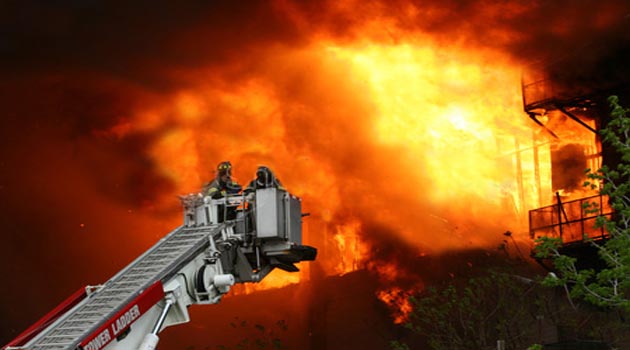INVESTIGATION OF FIRE DEBRIS
 INTRODUCTION
INTRODUCTION
A fire investigation is an unenviable task. The devastation, charred debris, collapsed structures, water soaked ashes, together with the smoke and stench, makes the task uninviting and seemingly impossible. The basic role of an investigator at a fire scene is twofold: firstly to determine the origin of the fire (the site where the fire began), and secondly to examine closely the site of origin to try and determine what it was that caused a fire to start at or around that location. An examination would typically begin by trying to gain an overall impression of the site and the fire damage; this could be done at ground level or from an elevated position. From this, one might proceed to an examination of the materials present, the fuel load, and the state of the debris at various places.
Fire debris is a general term used to define the materials collected from a fire scene for laboratory examination. When a fire investigator suspects that a fire might have been deliberately set using accelerants such as ignitable liquids, it is possible to collect and analyze fire debris to see if such products are present. Combustion requires three elements — heat, oxygen, and fuel. Fire will be extinguished when any one of these three elements is absent. Fire does not burn solids or liquids (in general), but rather the gases formed above them. Heat acts to vaporize the liquid or solid, converting it to a gas which then combines with oxygen to “burn” above the liquid pool. Thus, when flammable liquids soak into material or run into “cracks” there will be insufficient oxygen to support combustion. In these cases residue of ignitable liquids can be collected.
CLASSES OF FIRE:-
CLASS-A : Fire involving solid substances types, textiles, plastics, paper, coal, wood etc. CLASS-B : Fire involving liquid, alcohol, petroleum, oil, paint etc. CLASS-C : Fire involving gases like methane, Hydrogen, Acetylene, LPG etc. CLASS-D : Fire involving metal and their alloys Aluminum, Magnesium, Sodium, Potassium etc.COMMON CAUSE OF ELECTRICAL FIRE:-
SHORT CIRCUITS:-
- Agening of Insulating materials
- Damage to Insulating materials
- Poor Design & workmanship
- Components Failures & Extraneous factors
OVERHEATING:-
- Overloading
- Bad/Loose contacts
- Corroded joints
- Poor ventilation
- Jamming of motors
ELECTRICAL SPARKS:-
- Flammable dust/gases
LIGHTNING:-
- High Voltage – High current
STATIC ELECTRICITY:-
- Belts & Pulleys
HUMAN FACTORS:-
- Negligence
- Misuse
- Lack of skills
- Asron
CIRCUMSTANTIAL EVIDENCE FOR INSURANCE FRAUD:-
- Presence of Incendiary materials
- Multiple Origin of fire
- Suspicious Hours
- Holiday fires
- Vacant Buildings
- Recent departure of occupants
- Removal of valuable objects
- Building over insured
PROBLEMS IN ARSON INVESTIGATION:-
- Locating witnesses
- Locating & preserving physical evidence
- Determining whether victim is also the suspect
- Coordinating the investigation between police, fire and insurance agent
- Determining if the fire was arson or some other cause
COLLECTION OF EVIDENCE:-
- Charred debris and related materials from the origin where the accelerant was placed.
- Igniting devices like fuses candles
- Sample s of dry wall , plaster, wood or other materials that may have been penetrated by flammable liquids
- Sample of soil that may have been penetrated by flammable
- Trace evidence possibly left by the arsonist such as hairs, clothing fibers, materials etc.
- Suspected clothing worn at the time of crime including shoes
- Liquid containing possible accelerants
PACKING OF EVIDENCE:-
- Use airlight glass containers Seal each collected item separately and securely’
- Seal each collected item separately and securely
- Make all containers with appropriate identifiers
- Documents locations from which evidence samples were collected by notes/photographs
COMMON SAMPLING ERRORS:-
- Influncial samples taking samples from the wrong places or materials
- Ineffective sample preservation techniques
- No comparison samples
- Not maintaining an evidence chain custody
LABORATORY ANALYSIS:-
Samples are extracted with suitable solvent and injected on the gas chromatographs/mass selective detector (GC/MSD). The GC will separate all of the samples substances. The MSD will identify the samples substances.About The Author
SHASHI BHUSHAN,
FELLOW, IIISLA
GOVT. VALUER, CHARTERED ENGINEER
BOKARO STEEL CITY, M-9430704033




Leave a Reply